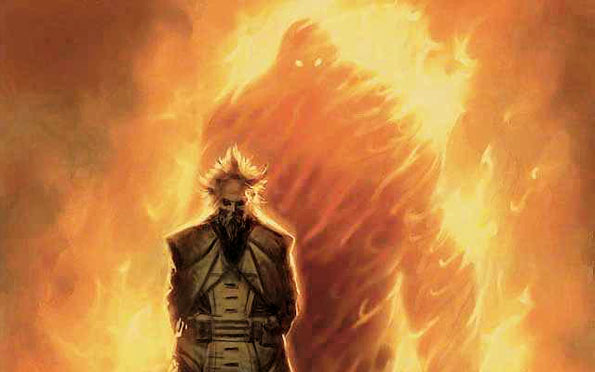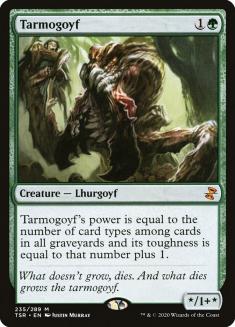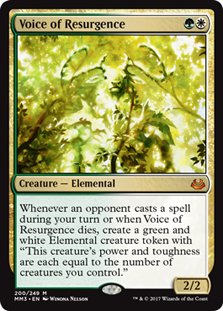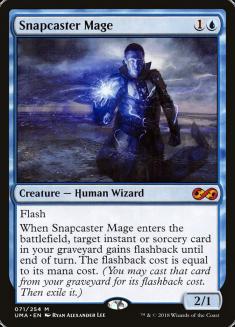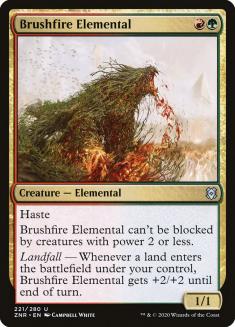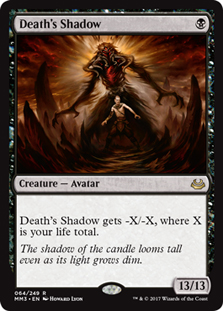I do in fact have a Modern Horizon 2 preview card for you today, but before I reveal it I… and you’ve already scrolled down.
Oh cool, you’re back! It’s pretty sick, right? Anyway, last year I spent a month inside the Wizards of the Coast (WotC) offices working on Modern Horizons 2 as part of their Future Future League (FFL). The group consisted of WotC employees Michael Majors, Dan Musser, and Zac Elsik alongside contractors Brian Braun-Duin, Sam Black, and me. It was a wild experiment and unique experience, one that I’ve been dying to tell you about!
When I say experiment, I’m saying that I don’t really know if they’ve ever done this with a FFL project before. They brought in three pro Magic players to join forces with a very experienced portion of Play Design to work extensively on a single set that was late in development. I was only there for all of twenty business days, but each one of them was jam-packed with meetings about Modern Horizon 2 cards. When we weren’t talking about potential changes to the cards, we were building decks and playing them against each other. It was a very focused experience.
There were also some awesome one-on-one meetings we had with other members of the team to help get us in the right mindset while we were in-house. One, in particular, was with Adam Prosak who is easily one of my favorite people in that building. In just a 30-minute talk, he taught me one of the most valuable lessons I could have possibly learned about card design.
The Community Only Sees the Final Product
As I was “the community” my entire time with Magic, I really needed to hear this. How I took this was that I, the consumer, am used to seeing a card at face value. A card is a card, and I must find other cards to properly synergize and interact with it. That’s a valuable skill that’s made me a lot of money on Magic’s professional circuit, but wasn’t going to help me while working on Modern Horizons 2.
While in development, a card can change time and time again. I could be the one changing it, or someone else could. I’ll remember all the previous iterations of cards, but I can’t let that previous knowledge influence me too much when reviewing the current versions. It doesn’t take much to make a bad card busted. Even a powered-down card might still be too good so it has to be tested again.
Let me tell you — a lot of cards had to be powered down! Now before you go grabbing your “power creep pitchforks,” this part of the process is extremely important. This set, by design, is supposed to impact Modern, a format which we all know is super-powerful already. It’s also the type of product that you want people to have fun with, so not every card has to be perfectly sculpted for competitive play (AKA what I’m used to).
This made me really take stock on how I could best utilize my time in the office. With limited experience, I trusted the word of the WotC employees I was working with and focused a lot of my energy on trying to break cards. Funnily enough, some of them turned out to be companions.
Sam Black and the Companioning
WotC also gave us a file of cards that would be released in other sets that they thought would have an impact on the Modern format. Sam Black quickly read over this file and took a dead stop at companions. He sat up from his desk, turned to us, and said something about eight-card openers. I hadn’t even gotten to that file yet, as I was gushing over some cards that haven’t even been previewed yet, and I’ll honestly say I didn’t share the same concern as Sam.
Yet.
This is by far my favorite part of my time at WotC — trying to work on Modern Horizons 2 while figuring out how companions played into that. Sam took a liking to Yorion, Sky Nomad and quickly started building 80-card deck after 80-card deck. His workspace started making him look like a mad scientist, which I guess he sort of is, and day after day he tried more and more Yorion decks. It was starting to become a problem in all honesty.
But like, he was right, right? His Yorion decks were awesome, and day after day he was competing with competitive Modern staples along with our “new brews.” The problem? Companions were coming whether we wanted them to or not and there wasn’t anything we could do about them.
I’ll be honest and say I did not share in the same fear that Sam had, and I was, of course, in the wrong there. His love of Yorion did influence me to build a lot more decks with Lurrus, which were quite good, but something in the back of my mind made me think this wasn’t a great use of my time. Sam’s an amazing deck designer and theorist, and was so much better than me at most aspects of the job. That’s why I wanted him to get off his Yorion kick and start breaking the cards we could change before heading out the door.
We butted heads a couple of times about this, as my point of view was that either he was wrong about companions, or he was right in which they’d need to be banned (or given errata). Both scenarios ultimately led to them not having an impact on the work we were doing at the moment.
Well in the end we were both right, but Sam was a little more right, showing me just how much I had to learn if I wanted to be a card designer/developer in the future.
Impossible Job Is Impossible
I didn’t know what I was going to be working on until I got there on the starting day. At first I was shocked it wasn’t Standard testing because, well, I’m the “Standard guy.” After I let that sink in, and started going through the Modern Horizons 2 folder, I started acquiring an undeserved level of confidence.
It quickly got shattered once I actually started digging into the work. Balancing cards for Modern is difficult! You want them to be fun, challenging, and, most importantly, not to break Modern in half. The job also takes a high level of imagination as you can always try to add small abilities to cards that could give them that “it factor.”
In all honesty, I don’t think I did that great of a job while I was there, but at the same time I learned just how impossible that job is. Magic: The Gathering is one of the most complicated games of all time, so it would make sense that creating new cards for it would be a challenge. That’s even before you take into account the increasing number of set releases and size of the department that designs/develops these cards. There’s just no way that enough games can get played for mistakes to not slip through the cracks here and there.
Now don’t get me wrong, egregious mistakes have been made in the past couple of years and I’m not defending them. Hell, I may now be to blame for some of them! If anything I think the Play Design team needs to be doubled in size. Those already there proved to be extremely competent at what they did. I know this, because every question I had that I thought was complicated was quickly answered with ease. These people know what they’re talking about and are passionate at what they do. It’s just that there’s only so many hours in the day.
Think about it. How many games do you think we play as a community? We’re all constantly playing and sharing our information with one another through articles, videos, streams, and Tweets. We play way more games combined the day a set releases than they ever could at the office. It’s actually quite impressive what they’re able to do when you put that into perspective.
Anyway, here’s one of those mistakes that I’m sort of responsible for.
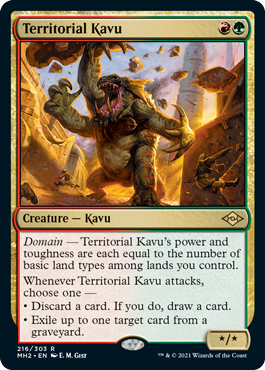
That’s right! Zoo is back on the menu!
This was one of the cards I was most excited about when I first read over the Modern Horizons 2 file, and even more excited when I got to be the person to preview it. I mean, this card is sick, right?
So what makes Territorial Kavu so good? Well, it all starts with just how powerful Modern has become relative to the pool of cards Zoo has access to. This archetype has taken on many shapes and sizes over the years, but for most of its existence, it was merely a fringe-playable strategy. One of those reasons could be that it never really had a great two-mana value creature!
Tarmogoyf was fine in the deck and all, but at the same time usually couldn’t attack for more than three until multiple turns of interaction occurred. Brushfire Elemental can attack for more, but always was in need of the perfect balance of lands and spells for lethal damage to be dealt. Territorial Kavu doesn’t care about frivolous things like interaction or continuous land drops. Territorial Kavu just wants to smash!
Now let’s talk about those abilities for a minute! Territorial Kavu having a “when it attacks” trigger allows for some very important things to happen. First, instead of needing more lands like Brushfire Elemental does, it can get rid of any excess ones you’ve drawn. This can help the deck significantly by finding any additional resources needed to close the door as quickly as possible.
Don’t need to sculpt your hand? The “exile up to one target card from a graveyard” ability may help slow down strategies trying to exploit the graveyard. I haven’t played Modern in a while, but I’m pretty sure there’s a lot of that going around!
Creatures (25)
- 4 Street Wraith
- 4 Steppe Lynx
- 4 Death's Shadow
- 3 Brushfire Elemental
- 4 Akoum Hellhound
- 2 Scourge of the Skyclaves
- 4 Territorial Kavu
Planeswalkers (2)
Lands (18)
Spells (15)

I don’t want to just shoehorn this card into being only used in Zoo decks wanting to burn opponents out with Tribal Flames. While I do believe it will be great there, another avenue might be possible as well. Territorial Kavu is really swole and may very well put Tarmogoyf out of a job. Getting all five land types onto the battlefield obviously comes with an opportunity cost, but this one might be worth it since it can really spruce up an already existing Jund Death’s Shadow deck.
Creatures (17)
Lands (19)
Spells (24)

Getting to discard unwanted cards is a gift you shouldn’t take lightly, especially in a strategy that wants to play hand disruption. You always want to play enough to have them in the early turns, but never want to draw them late. Well, Territorial Kavu fixes that by being able to continue pressuring an opponent while sifting through your unwanted cards!
Honestly, the sky is the limit when it comes to Territorial Kavu. It’s got the potential to really shake up how these multicolored aggro decks are designed and I can’t wait to see what the community does with it. I hope you enjoyed my talk about my time at WotC and I’m excited to see you claim all the territory you can with this mighty Kavu!

